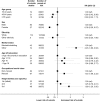Psychosocial characteristics as potential predictors of suicide in adults: an overview of the evidence with new results from prospective cohort studies
- PMID: 29353878
- PMCID: PMC5802587
- DOI: 10.1038/s41398-017-0072-8
Psychosocial characteristics as potential predictors of suicide in adults: an overview of the evidence with new results from prospective cohort studies
Abstract
In this narrative overview of the evidence linking psychosocial factors with future suicide risk, we collected results from published reports of prospective studies with verified suicide events (mortality or, less commonly, hospitalisation) alongside analyses of new data. There is abundant evidence indicating that low socioeconomic position, irrespective of the economic status of the country in question, is associated with an increased risk of suicide, including the suggestion that the recent global economic recession has been responsible for an increase in suicide deaths and, by proxy, attempts. Social isolation, low scores on tests of intelligence, serious mental illness (both particularly strongly), chronic psychological distress, and lower physical stature (a marker of childhood exposures) were also consistently related to elevated suicide rates. Although there is some circumstantial evidence for psychosocial stress, personality disposition, and early-life characteristics such as bullying being risk indices for suicide, the general paucity of studies means it is not currently possible to draw clear conclusions about their role. Most suicide intervention strategies have traditionally not explored the modification of psychosocial factors, partly because evidence linking psychosocial factors with suicide risk is, as shown herein, largely in its infancy, or, where is does exist, for instance for intelligence and personality disposition, the characteristics in question do not appear to be easily malleable.
Conflict of interest statement
The authors declare that they have no conflict of interest.
Figures





References
-
- WHO. Preventing Suicide: A Global Imperative. Geneva: World Health Organization; 2014.
Publication types
MeSH terms
Grants and funding
- MC_U147585827/MRC_/Medical Research Council/United Kingdom
- MC_QA137853/MRC_/Medical Research Council/United Kingdom
- MC_U147585819/MRC_/Medical Research Council/United Kingdom
- MC_UP_A620_1014/MRC_/Medical Research Council/United Kingdom
- MC_PC_17228/MRC_/Medical Research Council/United Kingdom
- G0400491/MRC_/Medical Research Council/United Kingdom
- MC_U147585824/MRC_/Medical Research Council/United Kingdom
- MC_UU_12011/2/MRC_/Medical Research Council/United Kingdom
- RG/08/014/24067/BHF_/British Heart Foundation/United Kingdom
- MR/K026992/1/MRC_/Medical Research Council/United Kingdom
- MR/L003120/1/MRC_/Medical Research Council/United Kingdom
- MR/K013351/1/MRC_/Medical Research Council/United Kingdom
- MC_UU_12011/1/MRC_/Medical Research Council/United Kingdom
LinkOut - more resources
Full Text Sources
Other Literature Sources
Medical

